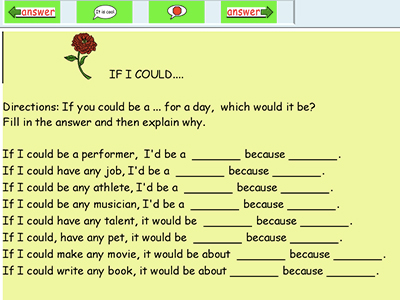Developing self-knowledge: Students engage in activities to explore different possibilities.
Purpose
Students use their imaginations to open up the possibilities and use their daydreams to help them decide what is really important to them.
Students deepen self-knowledge by identifying preferences and interests, expressing their unique ideas and brainstorming a list of both fantasy/imaginary things to be, as well as things that are actually attainable. Students share their ideas as well as their reasons and rationales for their choices with others.

Activity
Students complete a fill-in-the-blank worksheet to identify who/what they would be for a day. Students elaborate and explain reasons for their opinions. Students participate in a group discussion to share their responses. Students use language to express opinions and compare and contrast their ideas with those of their peers. Students are encouraged to elaborate and provide support and rationale for their opinions.

If I Could Be…Worksheet in Classroom Suite 3

If I Could…Worksheet in Classroom Suite
Adaptations
- Read worksheet aloud to student.
- Provide student with a talking word processing program and/or word prediction for spelling support.
- Elaborate and give examples where appropriate.
- Shorten number of questions.
- Offer multiple choice answers, allow student to select a choice from 3-4 options within a set of plausible options.
- Use partner-assisted auditory-scanning or computer assisted scanning as needed.
- Offer dictated writing strategy for students who do not have access to independent writing tools, where the student communicates a response to someone, who then writes it down for them.
- Break down activity into multiple sessions.
- Encourage students to work in pairs or small groups to assist one another.

